In our fast-paced and demanding world, keeping track of our mental and emotional well-being has become increasingly important. The advent of technology offers a valuable solution for developing mood tracker apps.
These innovative applications provide individuals with a convenient and user-friendly platform to monitor and analyze their emotions, helping them gain insights into patterns and trends that may impact their mental health.
Beyond personal insights, mood tracker apps often have features that promote mindfulness and positive habit formation. From customizable reminders for self-care practices to guided meditation sessions, these applications aim not only to track but also actively contribute to users’ mental health and happiness.
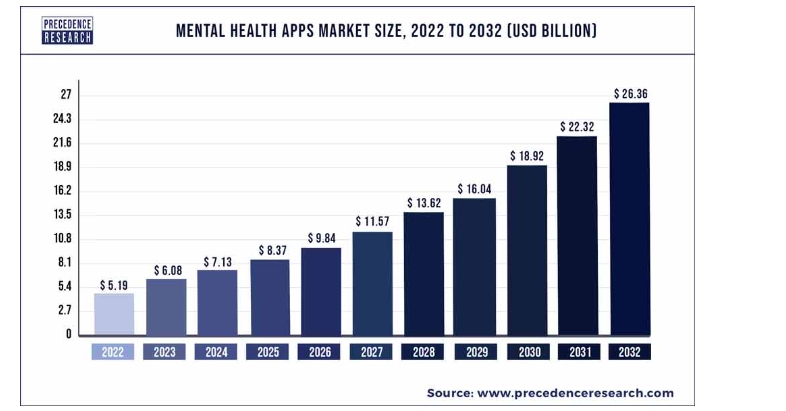
Source: PrecedenceReasearch
The expanding market for Mood Tracker Apps represents a significant business potential, reflecting the growing importance of mental health. Entrepreneurs entering this space can capitalize on the rising demand for intuitive, tech-driven solutions, providing a unique chance to contribute to both individual wellness and business success.
In this blog, explore the underlying principles of user-centric design, seamless functionality, and the incorporation of advanced technologies for developing a mood tracker app.
- What Are Mood Tracking Apps?
- How Mood Tracking Apps Work?
- Reasons Behind The Market Growth Of Mood Tracker Apps
- Must Have Features In A Mood Tracker App
- Strategies To Differentiate Your Mood-Tracking App
- How Businesses Can Monetize Their Mood Tracking App?
- Top 5 Mood Tracking Apps In The Market Right Now
- Technology Stack To Consider To Develop A Mood Tracking App
- Conclusion
- How Idea Usher Can Help In Developing A Mood Tracker App?
- FAQ
What Are Mood Tracking Apps?
Mood monitoring apps are computer programs that allow people to monitor and control their emotional well-being. These programs allow users to track and evaluate their moods, emotions, and actions. Users often provide information about their present mood, sleep habits, physical activity, and significant events or triggers. The objective is to fully understand one’s emotional state throughout time, allowing for insights into patterns, triggers, and potential links between lifestyle factors and mood swings.
Many mood-monitoring applications include configurable capabilities that allow users to establish customized objectives, reminders, and reflection prompts. Some applications utilize mood prediction algorithms or machine learning to provide users with information into prospective mood patterns and trends.
These applications encourage self-awareness and introspection, allowing people to make educated decisions regarding their mental health and well-being. The collected data may also be shared with healthcare experts, allowing for more informed conversations during therapy sessions or medical consultations. Mood-monitoring apps are effective tools for increasing mental health awareness and encouraging a proactive approach to emotional well-being.
How Mood Tracking Apps Work?
Embarking on a journey to better mental health often involves understanding and managing our emotions. In this section, we delve into the workings of these apps, exploring how they operate to enhance self-awareness and support overall well-being.
1. User Setup
Users initiate their journey with mood-tracking apps by digitally creating profiles that reflect their emotional well-being. During this setup, individuals customize various parameters crucial for accurate mood tracking. Mood descriptors, ranging from positive to negative emotions, provide a baseline for users to express their feelings. Activity levels and daily goals further tailor the app to individual preferences, fostering a personalized experience that aligns with the user’s mental health objectives.
Additionally, the setup phase may involve the option to input demographic details, facilitating a more holistic understanding of the user’s context. This initial configuration establishes the foundation for a comprehensive and tailored mood tracking experience, enabling users to track their emotional journey effectively.
2. Data Input
Once the user setup is complete, individuals regularly engage with the app by logging their daily moods. Mood tracking apps commonly feature simple interfaces that prompt users to select their current emotional state from a predefined list of emotions.
This streamlined process encourages consistent participation, making it easy for users to incorporate mood tracking into their daily routines. Beyond mood logging, users may input additional data points such as sleep patterns, physical activity, and noteworthy life events. This multifaceted input approach enriches the dataset, providing a more nuanced understanding of the factors influencing an individual’s emotional well-being.
3. Contextual Information
Mood tracking apps go beyond basic mood input by prompting users to provide contextual information. Details such as sleep patterns and physical activity play a pivotal role in understanding the broader context of an individual’s emotional states.
By considering external factors that may impact mood, these apps contribute to a more comprehensive analysis, facilitating a deeper understanding of the user’s emotional landscape.
This contextual information enhances the app’s ability to identify patterns and correlations between external factors and mood fluctuations, offering users a more holistic perspective on their mental well-being.
4. Customizable Features
To enhance user engagement and promote consistent mood tracking, many apps offer customizable features. These may include reminders and reflection prompts tailored to the user’s preferences. Reminders prompt users to log their moods at specific times, fostering a routine contributing to the app’s effectiveness.
Reflection prompts encourage users to delve deeper into their emotions, providing an opportunity for self-awareness and mindfulness. The ability to customize these features empowers users to shape their experience, aligning the app with their unique preferences and goals.
5. Data Analysis
Behind the scenes, mood-tracking apps leverage advanced technologies such as data analytics and, in some cases, machine learning algorithms. These tools analyze the collected data to identify patterns, trends, and potential triggers influencing the user’s emotional states.
The app distills large datasets into actionable insights by employing sophisticated algorithms, offering a more profound understanding of the user’s mental health journey.
This analytical process enables the app to adapt and evolve, refining its ability to provide personalized recommendations and predictions based on the user’s historical data.
6. Insight Generation
The culmination of user input and data analysis results in insights. Mood-tracking apps excel at extracting meaningful information from the amassed data, revealing personal mood trends and correlations [6]. These insights empower users with a heightened level of self-awareness, enabling them to identify patterns in their emotional life that may have gone unnoticed.
The app’s capacity to generate actionable insights contributes to a proactive approach to mental health, facilitating informed decision-making and personalized strategies for well-being.
7. Self-Awareness and Decision-Making
Ultimately, the overarching goal of mood-tracking apps is to empower users with self-awareness and facilitate informed decision-making regarding their mental health. With a wealth of insights from continuous mood tracking, users can make informed choices to improve their well-being.
Whether it’s adjusting daily routines, addressing specific triggers, or seeking professional support, the self-awareness cultivated through mood-tracking apps empowers individuals to take an active role in managing their mental health. This final step underscores the transformative impact of these apps on fostering a proactive and personalized approach to emotional well-being.
Reasons Behind The Market Growth Of Mood Tracker Apps
In a fast-paced world where mental health awareness is gaining prominence, the market for mood tracker apps is experiencing significant growth. Let’s explore the key reasons fueling the expansion of this market and the transformative impact these apps have on users’ mental health.
1. Increasing Mental Health Awareness
As society becomes more attuned to the importance of mental well-being, there is a growing awareness of the need to track and manage one’s mood. Mood tracker apps serve as valuable tools for individuals seeking proactive ways to monitor and enhance their mental health, contributing to the overall expansion of the market.
2. Convenience and Accessibility
The convenience offered by mood tracker apps contributes significantly to their popularity. With smartphones being ubiquitous, users can easily access these apps anytime, anywhere. The user-friendly interfaces and intuitive design of these applications make it effortless for individuals to incorporate mood tracking into their daily routines, fostering consistent usage.
3. Customization and Personalization
Many mood tracker apps provide users with the ability to customize their experience, tailoring the app to suit their unique preferences and needs. This personalization not only enhances user engagement but also ensures that individuals can find a tool that aligns with their specific mental health goals, fostering a sense of ownership and commitment.
4. Data-Driven Insights
The data analytics capabilities of mood tracker apps empower users with insights into their emotional patterns and triggers. This data-driven approach allows individuals to identify trends, understand the factors influencing their mood, and make informed decisions to improve their mental well-being. This emphasis on self-awareness drives the sustained growth of the market.
5. Integration with Wearable Technology
The integration of mood tracker apps with wearable devices further augments their popularity. Wearable technology allows for continuous monitoring and real-time feedback, providing users with a seamless and comprehensive approach to mental health management. This integration enhances the overall user experience and attracts a tech-savvy audience.
6. Corporate Wellness Initiatives
Companies are increasingly recognizing the importance of employee well-being, leading to the integration of mood tracker apps into corporate wellness programs. As employers prioritize mental health in the workplace, the demand for these apps as tools for stress management and emotional well-being support continues to rise, contributing to market growth.
7. Crisis Response and Prevention
Mood tracker apps often include features that enable crisis response and prevention. Some apps can detect patterns indicative of a mental health crisis and provide timely interventions or connect users with appropriate resources. This preventive aspect adds an extra layer of value, attracting users who prioritize proactive mental health management.
8. Social Connection and Support
Many mood tracker apps incorporate social features, allowing users to connect with a community of like-minded individuals. This sense of shared experience and support fosters a positive and collaborative environment. The social aspect not only enhances user engagement but also contributes to the destigmatization of mental health issues, driving the continued growth of the mood tracker app market.
Must Have Features In A Mood Tracker App
A robust mood tracker should encompass the following essential features that not only facilitate effective emotion logging but also contribute to users’ overall well-being.
1. Friend List Integration
In times of stress or a bad day, users often seek someone to talk to. The Friend List Integration feature addresses this need by providing a dedicated section for users to find and connect with friends. Users can add friends from their contact list, social media, or manually include phone numbers. This feature enhances the social aspect of the app, fostering a supportive environment for users to share their emotions and seek assistance when needed.
2. Integration with Wearables
Ensuring Integration with Wearables is crucial for meeting the diverse needs of consumers. This feature allows users to calculate metrics such as heart rate and pulse rate through wearable devices, providing additional health-related data for a more comprehensive view. Offering tools within the app to analyze how thinking patterns impact stress and anxiety further enhances the user’s self-awareness.
3. Health Diagnosis
The Health Diagnosis feature in mood tracking apps facilitates the monitoring of users’ health symptoms related to mental health conditions such as depression, bipolar disorder, and anxiety. This feature serves both users and medical practitioners, offering detailed information on progress in managing these disorders. It plays a crucial role in bridging the gap between self-monitoring and professional healthcare support, contributing to a holistic approach to mental well-being.
4. Social Media Integration
Social Media Integration is a key feature borrowed from fitness apps like Fitbit, adding an extra layer of connectivity to mood tracking apps. This feature enables users to seamlessly share their mood data with healthcare professionals and others in real-time. The collaborative aspect allows experts to gather and analyze emotional data, leading to more effective strategies for combating issues like depression.
5. Set Goal
The ‘Set Goal’ feature is an essential component that encourages users to establish daily, weekly, or yearly goals related to their emotional well-being. This feature promotes proactive steps toward achieving these goals, fostering a sense of accomplishment and improvement in mental health and overall wellness.
6. Statistics & Calendar
The Statistics & Calendar feature provides users with a comprehensive overview of their mood trends over an extended period. Enabling users to track mood swings anytime and anywhere, this feature contributes to self-awareness and a deeper understanding of emotional patterns. The visual representation enhances user engagement and facilitates informed decision-making.
7. Community Support
Community Support is a vital feature that allows users to connect with a global community facing similar psychological challenges. This inclusive feature provides a platform for users to share experiences, seek advice, and support each other in their mental health journeys. Building a supportive network enhances the overall effectiveness of the mood tracking app in promoting well-being.
8. Mix and Match Games
To enhance user engagement and provide effective stress relief, mood tracker apps can integrate Mix and Match Games. These interactive elements, including games, audio, activities, and mood improvement tools, contribute to a holistic approach in managing stress, anger, and anxiety. Incorporating playful elements adds a dynamic and enjoyable dimension to the app experience.
9. Mood Chart
Visual representation is a powerful tool for comprehending complex information, and the Mood Chart feature capitalizes on this by plotting graphs and charts using different dimensions. This visual representation enables users to focus on specific times or situations, providing a clear and concise depiction of their emotional states. The Mood Chart feature enhances the analytical capabilities of users, offering valuable insights into their emotional patterns.
10. Mood Diary
The Mood Diary feature serves as a central component of mood tracking apps, allowing users to log and document their emotional states throughout the day. Analogous to maintaining a personal diary, this feature encourages users to provide detailed information about their feelings, duration of emotional states, and more. Some applications incorporate sets of specific questions to offer users a comprehensive understanding of their emotional well-being, fostering a nuanced approach to mood tracking.
Strategies To Differentiate Your Mood-Tracking App
In a saturated market of mood-tracking apps, employing unique strategies is essential to differentiate your app and capture user attention. Here are strategies to consider:
1. Enhance User Experience with Intuitive Navigation
Creating a seamless and enjoyable user experience is crucial for a mood-tracking app. A user-friendly interface with intuitive navigation ensures that users can effortlessly navigate through the app without feeling overwhelmed. Incorporate design elements that promote a calm and soothing atmosphere, aligning with the app’s purpose of tracking and improving mood. Consider easy-to-understand features and a minimalist design that fosters a stress-free user experience.
2. Harness the Power of AI and ML Technologies
Stay at the forefront of technology by integrating artificial intelligence (AI) and machine learning (ML) into your mood-tracking app. These advanced technologies can provide users with insightful analytics, helping them understand the intricate connections between various factors and their moods. Additionally, AI and ML can offer personalized recommendations to uplift users based on their preferences, contributing to a more effective and tailored mood improvement experience.
3. Establish a Unique Selling Proposition (USP)
In a saturated market of mood-tracking apps, having a unique selling proposition (USP) is essential for differentiation. Consider incorporating distinctive features that set your app apart. For example, integrating a chatbot for personalized interactions or including Internet of Things (IoT) mood trackers that offer real-time data can make your app more engaging and valuable for users.
4. Avoid Feature Overload
While aiming for uniqueness, it’s crucial not to overwhelm users with unnecessary features. Simplicity is key, and overloading the app with irrelevant functionalities may confuse and deter users. Focus on providing essential and impactful features that align with the app’s core purpose – tracking and improving mood. Keep the user interface clean, straightforward, and easy to navigate.
5. Integrate Gamification for Enhanced Engagement
Incorporating gamification techniques can enhance user engagement with your mood-tracking app. Consider integrating stress buster games or implementing a reward system where users earn points for achieving positive mood states. Gamification adds an element of fun and encourages users to regularly interact with the app, fostering a habit of mood tracking.
How Businesses Can Monetize Their Mood Tracking App?
In an era where mental well-being is a priority, businesses with mood tracking apps can leverage various monetization strategies to capitalize on the growing demand for personalized mental health solutions.
1. In-app Advertising
In-app advertising proves to be a lucrative strategy for monetizing mood tracking apps. By incorporating third-party advertisements within the app interface, businesses can generate revenue based on user interactions such as views, clicks, and conversions. This approach is widely recommended by wellness software companies as an accessible and profitable method. It allows app developers to establish partnerships with advertisers, providing a platform for targeted promotions without compromising the user experience. Successful implementation requires a balance between ad visibility and user engagement, ensuring a seamless integration that benefits both the app’s developers and advertisers.
2. Sponsorship and Partnerships
An alternative avenue for revenue generation involves establishing partnerships and sponsorships with reputable healthcare and wellness organizations. Through real-time access to user data and related insights from the mood tracking app, these organizations offer substantial financial returns. It’s essential to highlight that user personal information is not shared without explicit consent, emphasizing a commitment to user privacy. This approach not only diversifies revenue streams but also strengthens the app’s credibility by aligning with established healthcare entities. Careful consideration of data privacy and mutually beneficial terms is key to successful partnerships in this monetization strategy.
3. In-app Purchases
In-app purchases emerge as a versatile and effective method to generate profits from mood tracking app development. Compatible with both Android and iOS platforms, this monetization model enables entrepreneurs to earn revenue by offering exceptional features within the app. Users can make purchases for additional features, such as new emoticons or filtered reports of their annual mood records. This approach leverages the freemium model, providing users with a basic app experience while offering premium features for purchase. Striking the right balance between free and premium content ensures a compelling user experience while unlocking revenue streams for sustainable app development.
Top 5 Mood Tracking Apps In The Market Right Now
In today’s fast-paced world, managing mental well-being has become a priority, and these top 5 mood tracking apps offer intuitive interfaces and diverse features to empower users in understanding and enhancing their emotional states.
1. Moodfit

Moodfit stands out as a comprehensive mood tracking app that not only allows users to log their emotions but also provides valuable insights and practical tips for improving mental health. The app’s intuitive interface facilitates easy tracking of moods, enabling users to identify patterns over time. One notable feature is the inclusion of guided meditations and breathing exercises, offering a holistic approach to stress and anxiety management. Additionally, Moodfit fosters a sense of community with its social feature, allowing users to connect with others, share experiences, and provide support. With its multifaceted approach, Moodfit goes beyond simple mood tracking, empowering users to actively enhance their overall well-being.
2. Daylio
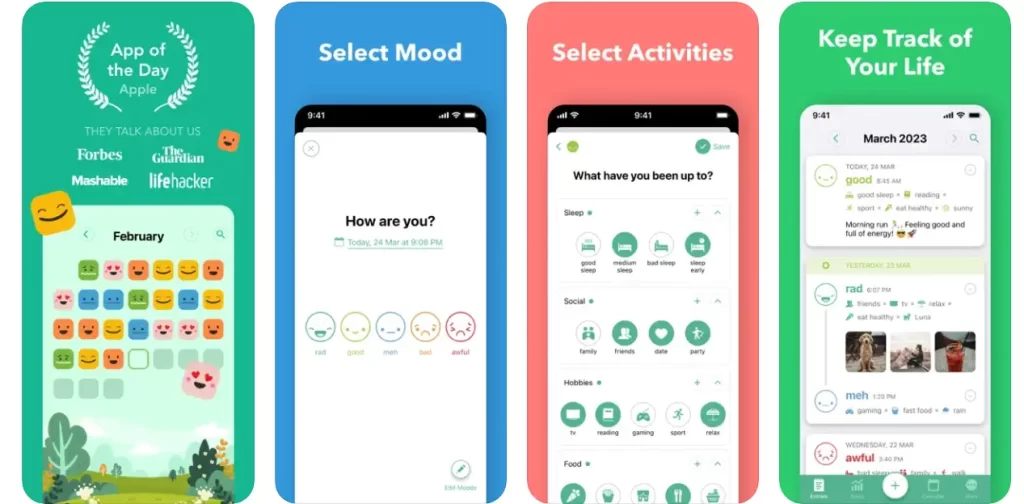
Daylio is a popular choice for those seeking a straightforward and user-friendly mood tracking experience. The app’s simplicity is evident in its daily mood logging, where users can select from customizable options like happy, sad, or neutral. Beyond mood tracking, Daylio supports users in setting and achieving mental health goals through features such as goal setting, stats tracking, and reminders. The app’s uncluttered interface and easy-to-use functionalities make it an accessible tool for individuals looking to gain insights into their emotional well-being and build positive habits.
3. Moodnotes
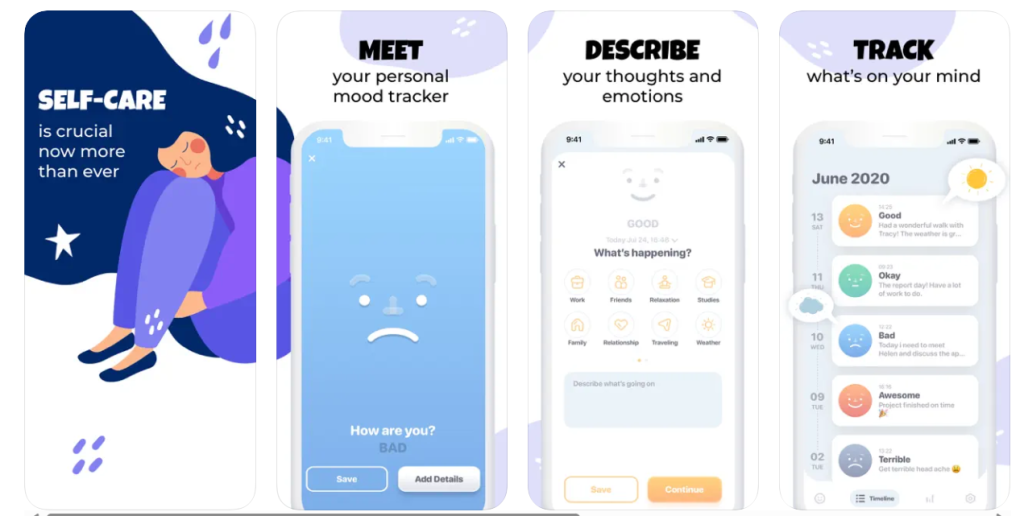
Moodnotes sets itself apart by being developed in collaboration with psychologists, incorporating cognitive-behavioral therapy (CBT) techniques. The app allows users to track their moods and thoughts, providing a platform to identify and challenge negative thinking patterns. The journaling feature encourages users to reflect on their emotions, fostering a deeper understanding of triggers and emotional responses. Moodnotes goes beyond simple tracking by offering personalized insights and tips based on users’ mood entries, providing practical guidance for improving overall well-being.
4. Pacifica
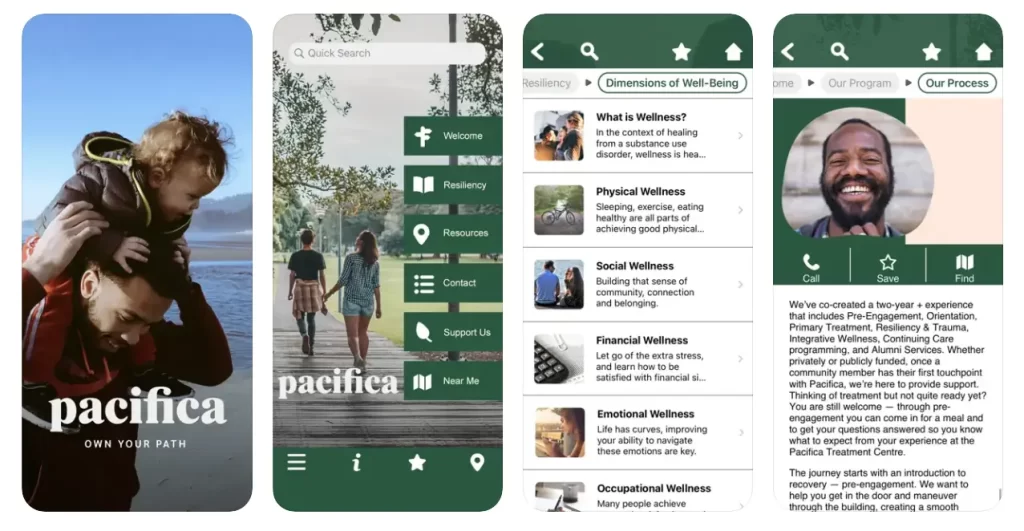
Pacifica takes a holistic approach to mental health by combining mood tracking with meditation, self-care activities, and mindfulness exercises. The app’s mood tracker enables users to log emotions, thoughts, and related events. Daily challenges and progress tracking feature prominently, encouraging users to build and maintain healthy habits. Pacifica’s inclusive community provides a supportive space for users to connect, share experiences, and offer encouragement. With its diverse set of features, Pacifica stands as an all-encompassing mental health app that addresses various aspects of well-being.
5. eMoods
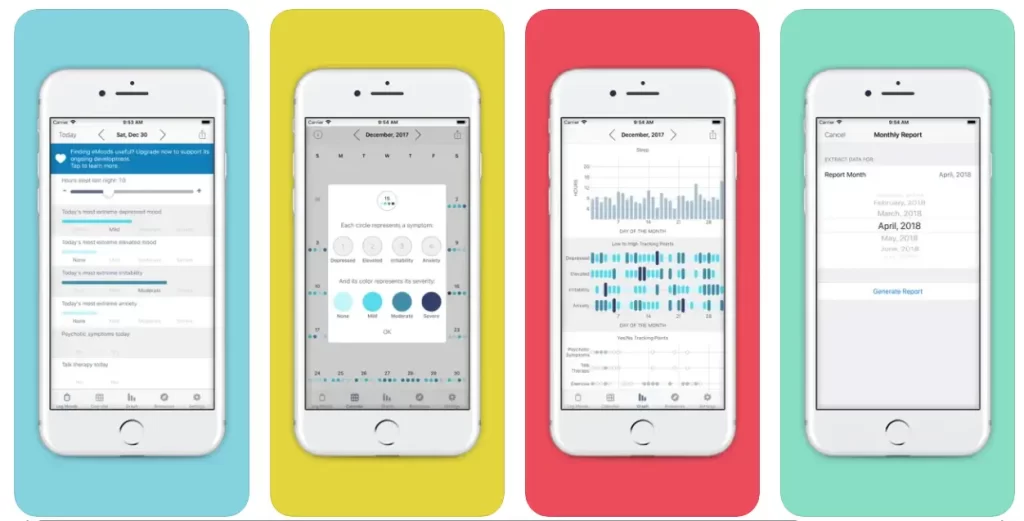
eMoods caters specifically to individuals diagnosed with bipolar disorder, offering a tailored approach to mood tracking. The app allows users to log daily moods, symptoms, medications, and behaviors in a customizable format. With the ability to set reminders for medications or therapy appointments, eMoods supports users in managing their condition proactively. Visual representations of mood trends and patterns offer valuable insights for both users and healthcare providers, facilitating a collaborative approach to bipolar disorder management. The app’s specialized focus makes it a valuable tool for those navigating the challenges of bipolar disorder.
Technology Stack To Consider To Develop A Mood Tracking App
Developing a mood tracking app requires a carefully chosen technology stack to ensure optimal performance, user experience, and scalability. Here’s a comprehensive technology stack that you might consider for developing a mood tracking app:
1. Frontend Development
- Framework: React Native or Flutter for cross-platform development, ensuring compatibility with both iOS and Android devices.
- Programming Languages: JavaScript (React Native) or Dart (Flutter) for building the app’s frontend components.
- UI/UX Design: Consider using tools like Figma or Adobe XD for designing an intuitive and visually appealing user interface.
2. Backend Development
- Server-Side Framework: Node.js with Express or Django for Python, providing a robust backend foundation.
- Database: MongoDB or PostgreSQL for storing user data securely. MongoDB is suitable for its flexibility, while PostgreSQL offers strong relational database capabilities.
- Authentication: Implement OAuth or JWT (JSON Web Tokens) for secure user authentication and authorization.
3. APIs and Integrations
- RESTful APIs: Design and implement RESTful APIs for seamless communication between the frontend and backend components.
- Third-Party Integrations: Integrate with relevant APIs, such as weather APIs for contextual mood tracking or meditation APIs for additional mental health features.
4. Cloud Services
- Cloud Hosting: Choose cloud platforms like AWS, Google Cloud Platform, or Microsoft Azure for scalable and reliable hosting services.
- Storage: Utilize cloud storage services (e.g., Amazon S3) for storing user-uploaded content or images associated with mood entries.
5. Real-Time Features
- Real-Time Database: Consider Firebase Realtime Database or WebSocket for implementing real-time features, such as instant mood updates or notifications.
- Push Notifications: Implement push notification services (Firebase Cloud Messaging, Apple Push Notification Service) to keep users engaged and informed.
6. Security
- SSL/TLS: Enable secure communication between the app and server using SSL/TLS protocols.
- Data Encryption: Implement end-to-end encryption for sensitive user data, ensuring privacy and security.
7. Testing
- Automated Testing: Use tools like Jest (for JavaScript) or PyTest (for Python) to automate unit testing and ensure code reliability.
- User Acceptance Testing (UAT): Conduct thorough testing of the app’s functionalities to identify and address any potential issues before deployment.
8. Analytics and Monitoring
- Analytics Tools: Integrate analytics tools like Google Analytics or Mixpanel to gather insights into user behavior and app performance.
- Error Monitoring: Implement tools like Sentry or Raygun to monitor and address errors promptly.
9. Version Control and Collaboration
- Version Control: Use Git for version control, and platforms like GitHub or GitLab for collaboration among development teams.
10. Scalability
- Containerization: Implement containerization with Docker for easy deployment and scalability.
- Load Balancing: Consider load balancing technologies to distribute traffic efficiently as the user base grows.
Conclusion
The development of a mood tracker app presents promising business opportunities in the ever-expanding wellness and mental health industry. As society places increasing importance on mental well-being, individuals are seeking accessible tools to monitor and manage their emotional states. The market demand for user-friendly, feature-rich mood tracking applications is on the rise, creating a fertile ground for innovative solutions.
The development of a mood tracker app represents a significant step forward in the realm of mental health and well-being. This innovative tool harnesses the power of technology to empower users to gain insights into their emotional states, fostering self-awareness and mindfulness.
Partnering with a professional app development company for the creation of a mood tracker app offers numerous advantages that can significantly enhance your business prospects.
How Idea Usher Can Help In Developing A Mood Tracker App?
Partnering with Idea Usher for the development of a mood tracker app presents a strategic and comprehensive solution that can greatly benefit your business objectives. Idea Usher’s proven track record in app development, coupled with their expertise in creating innovative and user-centric applications, positions them as a reliable partner for bringing your vision to life. Their skilled team of developers, designers, and project managers ensures a holistic approach to crafting a mood tracker app that is not only technically robust but also aesthetically pleasing and user-friendly.
Idea Usher’s commitment to customization allows for the adaptation of the mood tracker app to align seamlessly with your brand identity and target audience preferences. This tailored approach enhances the app’s appeal and increases its effectiveness in meeting the unique needs of your users. By leveraging their in-depth market knowledge, Idea Usher can assist in developing features and functionalities that set your mood tracker app apart from the competition, contributing to its success in the app marketplace.
Choosing Idea Usher as your development partner is a strategic investment in creating a top-notch mood tracker app that resonates with users and propels your business toward sustained success.
Contact us today to learn more about our app development service
FAQ
Q. How can a mood tracker app benefit users, and what features should be prioritized during development?
A. A mood tracker app can significantly benefit users by providing insights into their emotional well-being over time, helping them identify patterns and manage their mental health. When developing such an app, it’s crucial to prioritize features like intuitive mood logging, customizable categories, and insightful analytics. Additionally, integrating mood-enhancing activities or resources can enhance the overall user experience.
Q. What technologies and frameworks would be ideal for building a robust and scalable mood tracker app?
A. To ensure a robust and scalable mood tracker app, it’s recommended to leverage technologies like React Native or Flutter for cross-platform compatibility. Implementing a reliable backend using frameworks like Django or Flask (Python) or Express (Node.js) is essential. Integration with cloud-based databases such as Firebase or AWS can enhance data storage and retrieval capabilities, ensuring a seamless user experience.
Q. How can user privacy and data security be prioritized in the development of a mood tracker app?
A. User privacy is paramount in a mood tracker app. Incorporating end-to-end encryption for data transmission, implementing secure authentication protocols, and adhering to industry standards such as GDPR or HIPAA are crucial. Regular security audits and updates should be conducted to address potential vulnerabilities and ensure users’ sensitive information is safeguarded at all times.
Q. What strategies can be employed to create an engaging user interface and user experience in a mood tracker app?
A. Creating an engaging user interface involves designing a visually appealing and user-friendly layout. Prioritize intuitive navigation, seamless interactions, and a clean design that aligns with the app’s purpose. Implementing features like push notifications for mood check-ins, personalized insights, and interactive data visualization can enhance user engagement and retention.
Q. How can the mood tracker app be optimized for future updates and feature additions?
To optimize the app for future updates and feature additions, follow a modular and scalable architecture. Use version control systems like Git to manage codebase changes efficiently. Adopting an agile development approach allows for iterative updates and quick incorporation of new features based on user feedback. Additionally, maintaining comprehensive documentation will assist future development teams in understanding the app’s structure and functionalities.










Gaurav Patil